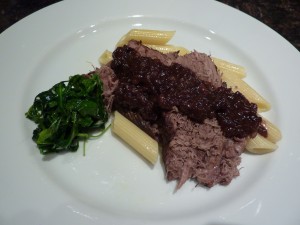
This recipe is an adaptation of “Pot Roast of Beef Braised in Amarone Wine”, from The Essentials of Italian Cooking by Marcella Hazan. It is preceded in the book by a very similar recipe, “Pot Roast of Beef Braised in Red Wine”. The former is assigned to Veneto, as it uses Amarone wine from Verona. The latter is attributed to Piedmont, as it uses a Barolo. You can see the pattern here – same dish, just use whatever regional wine is at hand to make it a local favorite.
Here in the US, the only Amarone wines I come across are over $30 a bottle, a bit too much for me to use for a cooking wine unless it is a very special occasion. Still wanting to keep this a dish from the Veneto, I substituted a Ripasso della Valpolicella wine. Both Amarone and Valpolicella hail from the Verona region of the Veneto. For the Ripasso wines, the leftover grape skins and seeds from the Amarone fermentation process are added to Valpolicella, and the mixture is allowed to macerate for an extended period of time. The Ripasso della Valpolicella wines are fuller-bodied, with a higher alcohol content, making it an excellent substitute for the Amarone in this recipe.
Braising Basics
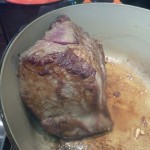
Braising is one of my favorite ways to cook meat. It is a fantastic way of transforming any inexpensive cut of meat into a delicious dinner. And the leftovers are even better!
Most every braise uses the same basic technique. The meat, anything from beef, pork, lamb, chicken, or turkey, is first browned in some sort of hot fat. Vegetables, most commonly a mirapoix or soffrito (onions, carrots and celery) are browned also. A liquid is added, enough to come about 1/2 to 2/3 up the side of the meat, not more. The pot is then covered, and the meat cooked over low heat in the slowly simmering liquid.
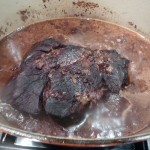
The cooking liquid and the juices released by the meat during the cooking process meld together. These more economical cuts of meat contain a relatively high amount of connective tissue. This slow cooking method releases the gelatins and collagens in this connective tissue, which adds body and enriches the cooking liquid. This is why you would not braise an expensive cut of meat, such as a tenderloin – the lack of connective tissue in these meats make them great on the grill, but poor choices for braising. A braise is done when the meat is falling apart. The cooking liquid is then reduced to make a wonderful sauce.
A braise can be prepared in advance. In fact, it is best prepared in advance! A night in the refrigerator only improves the flavors. You simply take the entire pot off the stove when the braise is done, and place the pot in the refrigerator. Just before serving, reheat on the stove. Remove the meat from the cooking liquid and set aside. Reduce the cooking liquid to a sauce of the desired thickness. Place the meat back in the sauce to reheat, and serve.
Braised Pot Roast in Ripasso della Valpolicella
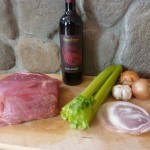
Serves 8
4 tablespoons extra virgin olive oil
4 pounds beef chuck
4 tablespoons extra virgin olive oil
Kosher salt and freshly ground black pepper
4 tablespoons pancetta, chopped
1 cup onion, chopped into 1/4 inch dice
1 cup celery, peeled and chopped into 1/4 inch dice
2 garlic cloves, minced
1 bottle Ripasso della Valpolicella
For any braise, use a heavy bottomed pot with a tight fitting lid, large enough to accommodate the meat.
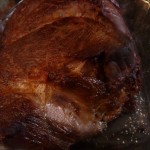
Season the meat on all sides with the salt and pepper. Heat the pot over medium high heat. Add the olive oil. Sear the meat on all sides until nicely browned all over. I often prop the meat against the side to sear a side that the meat cannot balance on unsupported. I’ve even held the meat up, using a dishtowel, while the meat sears on one last side that I can’t seem to get onto the bottom of the pan any other way!
Remove the beef from the pan and set aside. Add the pancetta, onion and celery to the pan and cook until the vegetables are beginning to soften and the pancetta beginning to brown, about 4 minutes. Add the garlic, and cook until aromatic, about another minute.
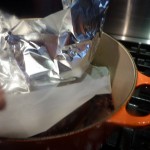
Place the beef back in the pan. Pour the bottle of wine over the beef. Cover the beef with a sheet of parchment paper, then a sheet of aluminum foil. This ‘inverted lid’ lies close to the meat, supposedly (according to culinary legend, and author of The Making of a Cook, Madeline Kamman) trapping the steam and insuring a tender final product. The layer of parchment paper is there to protect the foil from the acids in the wine that may react with the aluminum. Cover the pot with the lid. Bring the wine to a boil, then reduce the heat so the liquid is barely simmering.
Cook for 3 hours over very low heat, turning the meat from time to time. The meat is fully cooked when it is extremely tender, falling apart when pulled with a fork.
Remove the meat from the pan, and increase the heat to medium. Reduce the remaining cooking liquid until it becomes a nice sauce. Slice the meat into thin slices, and serve with the sauce.
Braised Beef Ragu (Lunch the next day)
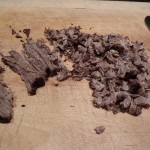
Take the leftover meat, and chop it into small pieces. Place in a saucepan, and add the leftover braise sauce. Heat. Add water if needed to thin. Serve over pasta.
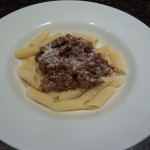

Pingback: Corteforte and Enoteca della Valpolicella with Italiaoutdoors | Italian Food, Wine, and Travel